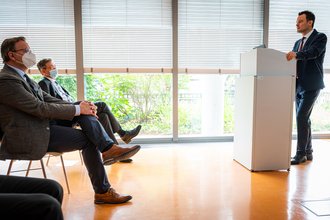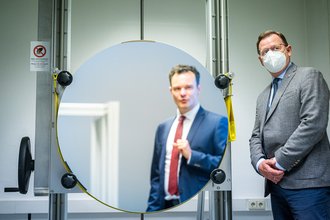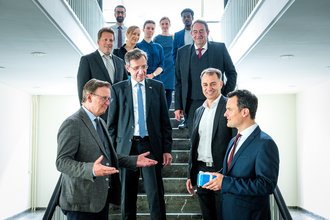
News about research
Prime Minister of Thuringia Ramelow Visits the Bauhaus-Universität Weimar and Finds out More About Research into Optical Schlieren Methods
Prime Minister of Thuringia Bodo Ramelow visited the Bauhaus-Universität Weimar on Wednesday 7 July as part of his »social cohesion« tour. The slogan of the day was »using technology to protect against infection«. In keeping with this topic, the Professorship of Building Physics presented the optical schlieren methods that have been used since the beginning of the Covid-19 pandemic to examine how breathing air spreads within a room and the effectiveness of different types of masks.
»Prime Minister Ramelow’s visit represents huge recognition for the researchers under the Professorship of Building Physics, whose work is making a key social contribution to establishing a detailed understanding and clear visualisation of how potentially infectious breathing air spreads within a room«, emphasised President of the Bauhaus-Universität Weimar Prof. Dr. Winfried Speitkamp.
During the one-hour meeting, Prime Minister Ramelow took advantage of the opportunity to learn the details of the research findings from the Professorship of Building Physics and to examine the question of how technological applications can ensure protection against infection. After the Prime Minister was welcomed by University President Speitkamp, Vice Dean of Research for the Faculty of Civil Engineering Prof. Dr. Horst-Michael Ludwig, and Mayor of Weimar Peter Kleine, Prof. Dr. Conrad Völker – Professor of Building Physics – presented his team’s research.
Using the two optical schlieren methods, namely the globally unique schlieren mirror and the background-oriented schlieren method (BOS), Weimar scientists have been able to visualise even the smallest airflows that would be invisible to the naked eye. Under the professorship, these schlieren methods are primarily being used to study indoor climates in interior spaces. However, the arrival of the coronavirus pandemic has produced some entirely new opportunities for application.
»In the context of the Covid-19 pandemic, we asked the question: What happens when we cough? How far does the resulting breathing air move into the room? And does wearing a face mask make a difference? Our investigations therefore also took practical applications into account and examined potentially infectious breathing air using the examples of face masks, ventilators, and also during singing and music performance in conjunction with the Thüringen Philharmonie Gotha-Eisenach orchestra and the Staatskapelle Weimar. We want our work to contribute to developing new hygiene and safety concepts. Our plan is to further improve the schlieren method in the future to enable even greater precision and informative value. It was therefore also important for us to build a new, larger climate laboratory«, Prof. Völker explained.
In the schlieren laboratory, attendees were able to gain a practical understanding of the research being undertaken thanks to a live demonstration. This involved the use of face masks as well as the »BauhausUniVisor«, a visor made of PETG film that was developed by product designers at the Bauhaus-Universität Weimar. The schlieren mirror was then used to compare the two scenarios against breathing out without any »protection«.
In April 2021, Building Physics researchers at the Bauhaus-Universität Weimar were awarded the Thuringia Research Prize in the »Applied Research« category in recognition of their research work on »optical schlieren methods to visualise indoor airflows«.
About the methods of measurement
Schlieren methods (schlieren mirror and BOS) are methods for visualising and measuring indoor airflows. The methods visualise density differences in the air, which in this case are due to air temperature, pressure and moisture. Just like hot air shimmering above an overheated road in the summer, the warm, damp air from breath has a different density to the cooler ambient air. These density differences deflect light, which can be seen as dark spots in a photo or video image. However, as the density differences in indoor airflows are very small, they can only be identified using the extremely sensitive setup of a schlieren or BOS system. There are currently only four large schlieren systems worldwide, which are being used in various different fields of research.
More information: Chair of Building Physics






















